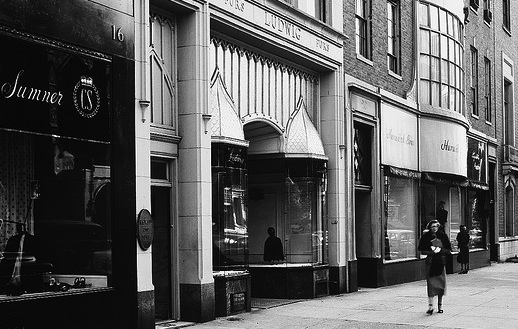
Image by MIT-Libraries/Flickr
Dear CMSi,
I am a local reporter in Bedford Falls. Recently, an old Main Street storefront that was condemned was taken down, as part of a major restructuring of the business section of town. I’d like to run some pictures of the different businesses that occupied that storefront, and in the town archives I discovered some great old photos. It would make a great Sunday feature, and I think we could even sell it as a supplement during the Bedford Falls Centennial.
Nobody was able to tell me anything about the photos, though; the archive is run by volunteers. Usually we get permissions for photos, but in this case, I don’t even know who to ask. Help!
Best,
Brian
Dear Brian,
Thank you for your question. It’s sometimes impossible to find the copyright holders for a work, even though you can pretty much bet that everything you come into contact with (yes, even if it’s on the Internet) is copyrighted. If you can’t find the owner, the work is often called “orphaned,” or an “orphan work.”
Fair use, the copyright right that permits unlicensed use of others’ material if you are creating new culture with it and using the appropriate amount, applies to orphan works the same way it applies to copyrighted works for which you know the owner. But would your use of those photos for a story on the end of an era on Main Street be a fair use?
It could be. But how do you make the call? To know if you’d be doing what your journalistic peers think is responsible, turn to the Set of Principles in Fair Use for Journalism. Situation Five says: “Fair use applies to journalistic incorporation of historical material.” To define what that principle means in practice, journalists think you should ask yourself these questions: Are you using the picture for a journalistic purpose? Are you only using the appropriate amount for your purpose? (And of course you’d likely be using 100% of the photos in many cases, as the law allows depending on your reason—that is, the first question you’d ask.) And have you thought about attribution? In the case of orphan works, for instance, you might let people know that you don’t know the origin or date of this picture, and would welcome that information. Maybe someone in Bedford Falls will recognize it and help out!
Your feature story on the history of the storefront, at the time of its final end, will clearly have some long-lasting value but also new journalistic significance during the Centennial. You’d probably want to do some journalistic work making this feature relevant to the Centennial.
Whether your uses are commercial or not (for instance, whether you’d be selling the supplement) don’t figure much into fair use calculations. Many fair uses and very many journalistic fair uses involve commerce at some point.
Asking the questions journalists pose in the Set of Principles helps you think through your fair use reasons. Once you have answered these questions, you’ll be able to figure out whether using the picture constitutes fair use in conformity with the consensus of the profession, and you can make your fair use call with confidence.
